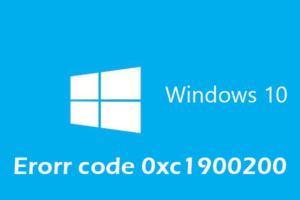-
Table of Contents
- Understanding the Implications of Microsoft Ending Support for Windows 10 Version 21H2
- Steps to Update Your Windows 10 Version to Ensure Continued Support
- Exploring the New Features and Enhancements in the Latest Windows 10 Update
- Preparing for the Future: What Microsoft’s Decision Means for Windows 10 Users
- Q&A
Microsoft ends support for Windows 10 version 21H2, asks users to update.
Microsoft has announced the end of support for Windows 10 version 21H2 and is urging users to update their operating systems.
Understanding the Implications of Microsoft Ending Support for Windows 10 Version 21H2
Microsoft recently announced that it will be ending support for Windows 10 version 21H2, urging users to update to the latest version. This decision has significant implications for users who are still using this version of the operating system. In this article, we will delve into the reasons behind Microsoft’s decision and discuss the potential consequences for users who choose not to update.
First and foremost, it is important to understand why Microsoft has decided to end support for Windows 10 version 21H2. As technology evolves, software companies like Microsoft constantly strive to improve their products and provide users with the best possible experience. This means regularly releasing updates and new versions of their software to address security vulnerabilities, fix bugs, and introduce new features.
By ending support for older versions, Microsoft can focus its resources on developing and maintaining the latest versions of Windows 10. This allows them to provide better support and ensure that users have access to the most up-to-date features and security patches. It also helps streamline their operations and reduce the complexity of supporting multiple versions simultaneously.
For users who choose not to update to the latest version of Windows 10, there are several potential consequences. The most significant is the increased risk of security vulnerabilities. Without regular updates and security patches, older versions of operating systems become more susceptible to cyberattacks and malware. Hackers are constantly looking for vulnerabilities to exploit, and unsupported software provides them with an easy target.
In addition to security risks, users may also experience compatibility issues with newer software and hardware. As technology advances, developers often optimize their products for the latest operating systems. This means that older versions may not be able to run certain applications or utilize new hardware features. This can be particularly problematic for businesses that rely on specific software or hardware configurations.
Furthermore, without support from Microsoft, users will no longer receive technical assistance or customer support for any issues they encounter. This can be frustrating and time-consuming, especially for non-technical users who rely on Microsoft’s expertise to troubleshoot problems. It also means that any bugs or glitches in the software will remain unresolved, potentially impacting the user experience.
To mitigate these risks and ensure a smooth transition, Microsoft strongly recommends that users update to the latest version of Windows 10. This can typically be done through the Windows Update feature, which automatically downloads and installs the necessary updates. However, it is important to note that updating to a new version of an operating system can sometimes be a complex process, especially for users with customized settings or specialized software.
In conclusion, Microsoft’s decision to end support for Windows 10 version 21H2 has significant implications for users who choose not to update. The increased risk of security vulnerabilities, compatibility issues, and lack of technical support are all factors that users should consider when deciding whether to update. By staying up-to-date with the latest version of Windows 10, users can ensure a more secure and optimized computing experience.
Steps to Update Your Windows 10 Version to Ensure Continued Support
Microsoft recently announced that it will be ending support for Windows 10 version 21H2, urging users to update their operating systems to ensure continued support. This move comes as part of Microsoft’s ongoing efforts to provide the best possible user experience and security for its customers.
Updating your Windows 10 version is a crucial step in ensuring that your computer remains secure and up to date with the latest features and improvements. Microsoft regularly releases updates to address security vulnerabilities, fix bugs, and enhance performance. By staying on an unsupported version, you risk exposing your computer to potential security threats and missing out on important updates.
To update your Windows 10 version, follow these steps:
1. Check your current version: Before proceeding with the update, it’s essential to know which version of Windows 10 you are currently running. To do this, click on the Start menu, then go to Settings > System > About. Under the Windows specifications section, you will find the version and build number. Make a note of this information as you will need it later.
2. Backup your data: Before making any major changes to your operating system, it’s always a good idea to back up your important files and data. This ensures that even if something goes wrong during the update process, you won’t lose any valuable information. You can use external storage devices or cloud services to create a backup of your files.
3. Check for compatibility: It’s crucial to ensure that your computer meets the system requirements for the latest version of Windows 10. Visit the Microsoft website or use the Windows Update Assistant tool to check if your hardware and software are compatible with the new version. If any compatibility issues are identified, you may need to update certain drivers or software before proceeding.
4. Download and install updates: To update your Windows 10 version, go to Settings > Update & Security > Windows Update. Click on the “Check for updates” button to search for available updates. If a new version is found, click on the “Download and install” button to initiate the update process. Depending on the size of the update and your internet connection speed, this process may take some time. It’s important not to interrupt the update process to avoid any potential issues.
5. Restart your computer: Once the update is downloaded and installed, you will be prompted to restart your computer. Save any ongoing work and close all open applications before proceeding with the restart. After the restart, your computer will be running the latest version of Windows 10, ensuring continued support and security.
By following these steps, you can easily update your Windows 10 version and ensure that your computer remains secure and up to date. Microsoft’s decision to end support for Windows 10 version 21H2 highlights the importance of staying current with software updates. Regularly updating your operating system is a simple yet effective way to protect your computer from security threats and enjoy the latest features and improvements.
In conclusion, Microsoft’s announcement regarding the end of support for Windows 10 version 21H2 serves as a reminder for users to update their operating systems. By following the steps outlined above, you can ensure that your computer remains secure and up to date with the latest features and improvements. Don’t delay in updating your Windows 10 version to continue receiving support from Microsoft and to keep your computer running smoothly.
Exploring the New Features and Enhancements in the Latest Windows 10 Update
Microsoft recently announced that it will be ending support for Windows 10 version 21H2 and is urging users to update to the latest version. This move comes as no surprise, as Microsoft has a history of regularly updating its operating system to ensure security and performance improvements. In this article, we will explore the new features and enhancements that come with the latest Windows 10 update.
One of the most notable features in the latest update is the improved Start menu. Microsoft has made changes to the layout and design, making it more streamlined and user-friendly. The new Start menu now includes a simplified layout with a centered app list and a new grid of icons. This change not only enhances the visual appeal but also makes it easier for users to navigate and find their desired applications.
Another significant enhancement in the latest Windows 10 update is the introduction of virtual desktops. Virtual desktops allow users to create multiple desktops and switch between them seamlessly. This feature is particularly useful for individuals who work on multiple projects or need to separate their personal and professional tasks. With virtual desktops, users can organize their workspaces efficiently and improve productivity.
Microsoft has also made improvements to the Windows Store in this update. The Windows Store now offers a wider range of apps and games, making it a one-stop-shop for all software needs. Additionally, Microsoft has introduced a new design for the Windows Store, making it more visually appealing and easier to navigate. These enhancements aim to provide users with a better overall experience when searching for and downloading applications.
In terms of security, the latest Windows 10 update brings several enhancements to protect users’ data and privacy. Microsoft has introduced Windows Hello, a biometric authentication feature that allows users to log in using facial recognition or fingerprint scanning. This feature adds an extra layer of security, making it more difficult for unauthorized individuals to access sensitive information.
Furthermore, Microsoft has improved the Windows Defender Antivirus in this update. The antivirus software now includes enhanced threat protection capabilities, ensuring that users are better protected against malware and other malicious software. With these security enhancements, users can have peace of mind knowing that their data is safeguarded.
In addition to these major features and enhancements, the latest Windows 10 update also includes several smaller improvements that contribute to an overall better user experience. These include performance optimizations, bug fixes, and compatibility improvements with various hardware and software.
In conclusion, Microsoft’s decision to end support for Windows 10 version 21H2 and encourage users to update to the latest version is a step towards ensuring the security and performance of the operating system. The new features and enhancements in the latest Windows 10 update, such as the improved Start menu, virtual desktops, and enhanced security measures, aim to provide users with a better overall experience. By regularly updating their operating system, users can take advantage of these new features and ensure that their devices are running smoothly and securely.
Preparing for the Future: What Microsoft’s Decision Means for Windows 10 Users
Microsoft ends support for Windows 10 version 21H2, asks users to update. Preparing for the Future: What Microsoft’s Decision Means for Windows 10 Users.
In a move that has been anticipated for some time, Microsoft has officially announced the end of support for Windows 10 version 21H2. This decision has significant implications for Windows 10 users, as it means that those who are still using this version will no longer receive security updates or technical support from Microsoft. While this may come as a disappointment to some, it is important to understand the reasons behind Microsoft’s decision and the steps that users can take to ensure a smooth transition to a supported version of Windows 10.
First and foremost, it is crucial to recognize that Microsoft’s decision to end support for Windows 10 version 21H2 is part of their broader strategy to encourage users to upgrade to the latest version of their operating system, Windows 11. Windows 11 offers a range of new features and improvements over its predecessor, including a redesigned Start menu, enhanced gaming capabilities, and improved performance. By ending support for older versions of Windows 10, Microsoft is effectively pushing users towards the latest and most secure iteration of their operating system.
For Windows 10 users who are still on version 21H2, the first step in preparing for the future is to check if their device is eligible for an upgrade to Windows 11. Microsoft has provided a compatibility checker tool that can be downloaded from their website, which will assess whether a device meets the minimum system requirements for Windows 11. It is important to note that not all devices will be able to upgrade to Windows 11, particularly those that are older or have lower specifications. In such cases, users may need to consider purchasing a new device that is compatible with the latest operating system.
For those whose devices are eligible for an upgrade to Windows 11, the next step is to ensure that all important data and files are backed up before proceeding with the installation. While the upgrade process is designed to preserve user data, it is always wise to have a backup in case of any unforeseen issues. Microsoft provides a range of tools and resources to assist users in backing up their data, including the built-in Windows Backup and Restore feature.
Once the necessary preparations have been made, users can proceed with the upgrade to Windows 11. Microsoft has made the process as seamless as possible, with a simple and intuitive installation wizard that guides users through each step. It is important to note that the upgrade process may take some time, depending on the speed of the device and the amount of data being transferred. Patience is key during this stage, as interrupting the installation process could lead to errors or data loss.
After successfully upgrading to Windows 11, users can enjoy the benefits of a more secure and feature-rich operating system. It is important to regularly check for updates and install them promptly, as Microsoft continues to release patches and improvements to ensure the ongoing security and stability of the operating system. By staying up to date with the latest updates, users can ensure that their device remains protected against emerging threats and vulnerabilities.
In conclusion, Microsoft’s decision to end support for Windows 10 version 21H2 is a significant development for Windows 10 users. While it may require some effort to upgrade to Windows 11, the benefits of doing so are well worth it. By following the necessary steps and taking the time to prepare for the transition, users can ensure a smooth and secure upgrade to the latest version of Windows 10.
Q&A
1. What is Windows 10 version 21H2?
Windows 10 version 21H2 is a specific release of the Windows 10 operating system.
2. Why is Microsoft ending support for Windows 10 version 21H2?
Microsoft is ending support for Windows 10 version 21H2 to encourage users to update to newer versions that offer improved security and features.
3. What does it mean when Microsoft ends support for a Windows version?
When Microsoft ends support for a Windows version, it means that they will no longer provide security updates, bug fixes, or technical support for that specific version.
4. What should users do when Microsoft ends support for Windows 10 version 21H2?
Users should update their Windows 10 version to a newer supported version to ensure they continue receiving security updates and technical support from Microsoft.In conclusion, Microsoft has announced the end of support for Windows 10 version 21H2 and is urging users to update their operating systems.







![[Solved]: “Error Code 0xC004F050” in Windows 11 in No Time](https://www.tipsbin.net/wp-content/uploads/2023/08/8e64f519d2390bfc001a41744be2cbd4-300x199.jpeg)

